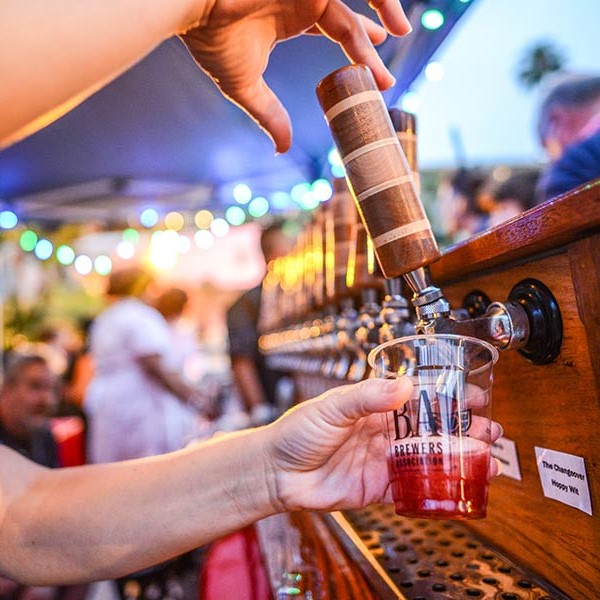
Drew Beechum is a past president of the Maltose Falcons and a frequent contributor to Zymurgy. This article appeared in the Mar/Apr 2008 issue of Zymurgy magazine.
Ah, that satisfied smirk creeps across your face when pulling the very first pint of beer on your spiffy two-tap kegerator reborn from an old broken down fridge. Gleaming, it stands a monument. What do you do when those few taps just aren’t enough and the party’s calling for more beer?
This issue vexes many clubs. Just how many individual dispense rigs can you have at a club get-together? The need is greater when your club starts pouring 20, 30, even 40 beers for a major homebrew festival party like the Southern California Homebrewers Festival (SCHF) or pouring your beer at commercial festivals like the Carolina BrewMasters Charlotte Oktoberfest (6,000 happy customers and climbing and 36 kegs down). Tales abound of some brewers’ epic charitable house parties cracking these numbers!
How do you clean up the endless tangle of cobra lines and give every beer the presentation it deserves? With a little money and some mechanical know how, you and your club can have a portable bar rig that showcases your efforts with the style they deserve.
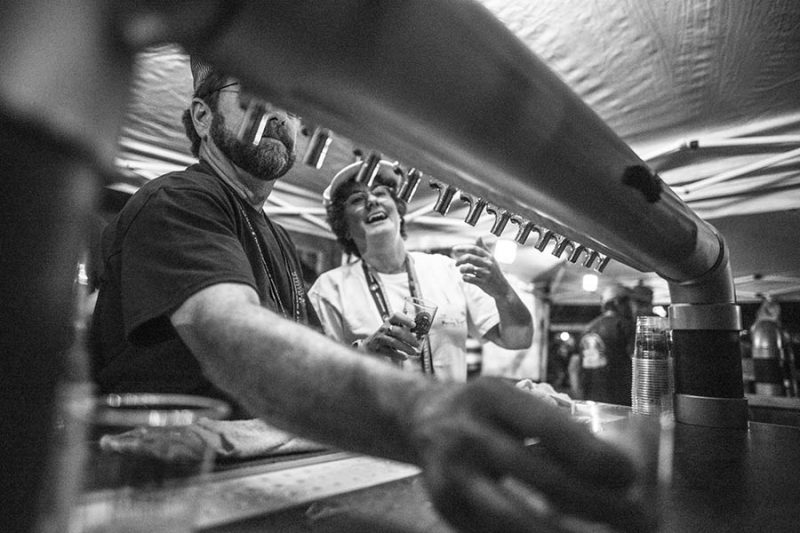
The Whys
How can owning a big party bar make a difference for you or your club? Typically, the Maltose Falcons proudly display our wares at four major shindigs. A few years back, we noticed that the amount of beer brought was dropping off, despite a growing membership and attendance. Turns out, members were frustrated that their beer missed being served from our 13-tap bar and ended up forlorn with a cobra line As our serving capacity has grown to more than 40 different taps, more beer keeps arriving!
Gaining neatness and efficiency from a centralized draft system simplifies the party day, particularly later on. Instead of worrying after myriad CO2 tanks, regulators and ice buckets, monitoring and adjusting any keg is handled easily. Thinking green, massed kegs and large cooler boxes or tubs reduce ice consumption.
Outsiders misperceive us as moonshiners keeping an eye peeled for those darn revenuers. More than one suspicious mind has been set at ease by the shining taps topped with custom tap handles. Watching new party attendees realize the depth and breadth of talents of homebrewers and that we mean business in our little backyard hobby is a great treat. As Kent Fletcher, Falcons builder extraordinaire, and I towed the bar to a beerfest, driving down tony Santa Barbara’s main drag, residents greeted us with gaping jaws and cheers for his masterpiece draft system.


Design Considerations
Designing a proper bar requires balancing your needs, options, funds and the tools and skills at hand. Where is the bar service happening? How many beers do you plan to serve? How do you plan to move the bar? Where does the bar reside when not in use? In terms of cost, our bars all cost between $200 and $500 to make and equip.
Portability is the primary concern for most of us. Some bars profiled break down into small pieces that fit comfortably in a pickup truck, while others require trailers and brute force to move. Increased setup time at your party site is the tradeoff with an ultra-portable bar, so consider how much time you have to spend assembling your masterpiece. Our older portable “Back Bar” takes a solid three hours from flat-packed to up-and-pouring-beer. Contrast that to the new “Front Bar” pouring beer in under a half hour at the cost of requiring larger transport.
Many beer festivals happen outdoors with loads of happy drinkers wandering around and the occasional over-indulger. Water, sand, dirt, trees, fearless dive-bombing squirrels and the natural leaning stance of the relaxed beer drinker combine with natural wear and tear to grind away that shiny new bar smell. In addition to protecting your bar by keeping it out of direct contact with the ground, you will want to use stout materials for a hoard-surviving bar. Cleaning the bar immediately after use is as critical to the quality of your bar and beer as thorough cleaning of your kegs. Fight the desire to veg after a long beer festival—clean the taps and surfaces and make that bar shine!
Hunting for bar parts is the sort of shopping I can get behind. While I normally advocate purchasing top quality parts, unless the bar is in operation regularly, less expensive rear seal faucets will suffice. Include in your bar “toolbox” a cheap faucet spanner, a stout faucet, gaskets, quick disconnects and markers. The great auctioneer of the Internet, eBay, is a great source for old bar equipment, including draft towers and beer engines. Instead of buying a tower, take a lesson from the Barley Engineers of San Diego and make a modern style “U” pipe from PVC water pipe mounted with shanks and faucets.
At home, we can get away with a single tank, regulator and gas line to pressurize and serve from our lines. Using a single tank and line at a fest leads to foamy or slow pours and the hassle of swapping tanks. The simplest approach is a single regulator that is “tee’d” into multiple gas lines, but you have no capability to adjust pressure for each keg. The black plastic screw-together manifolds are a safe bet. They allow you to restrict the gas flow and are easily expansible. If you plan on serving from beer engines, consider aiding the longevity of the keg by installing a “cask breather” valve (starting at about $80). Fed with 1-31 psi, the breather will blanket the beer with CO2 on every pull and keep your kegs fresh. As a bonus, it can service multiple engines. Steve Jones of Tennessee experimented and now recommends low-pressure propane regulators ($10-30) with added flares as a substitute.
Even if serving only real ale, you need to keep the chill on your beer. Your guests want to taste the cold! The standard answer of large tubs or trashcans of ice work, but thick polystyrene sheets glued together to form custom keg boxes work even better. Hard to find and more expensive than other options, the efficiency of an aluminum cold plate for pouring frosty beer is difficult to beat. Lastly, if you can find power, consider building a refrigerated brew trailer or a masterpiece like Pastor Tom’s “Brewpastor’s Altar.”
Commercial bars know that paying customers only buy what they know you have. They may not be paying, but guests still need to see what you have on tap! Placing erasable signs above every tap handle is a start. An old blackboard backing allows easy labeling of the Brewpastor’s Altar. Large dry erase boards on an easel or suspended with ropes (ala the Barley Engineers) are essential for a crowded environment and reduce dilly-dallying in front of the taps. Use bright fluorescent markers for punch and get the one person with legible writing to do it!
Be prepared for success! Unveil the new setup and discover demand outstripping your tap space. Be wise and plan for additional draft points or spots for mounting new hardware, such as beer engines.
Enough theory—what have your peers created? All of these bars have been featured at large scale festivals or the AHA National Homebrewers Conference and kept crowds happy with flowing suds. Do the world a favor and make your local beer bar blush when you roll down the street with a load of homebrew love.
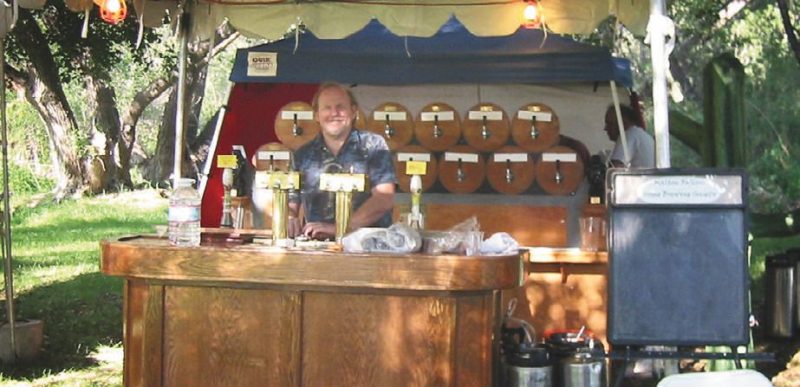
Maltose Falcons Front and Back Bars (36 Taps of Chaotic Love)
In the mid 1990s, the club decided we needed a better way to pour our beer at parties. Soon-to-be Falcons’ president Kevin Baranowski volunteered to build a mobile bar for the club. Working from plywood, Kevin fashioned a simple fold-flat design with 13 taps. Complete with signage and drip trays that feed into buckets and decorative Hashell Dammett statues, the bar is a mainstay for the club. The hinged foldout side-wings have flaps that sit on the ground. Four foam keg boxes filled with beer and ice hold the edifice upright. Mounted on short shanks, the faucets feed to labeled ports on the backside of the bar. Setup includes unfolding the bar and attaching the plastic gas manifold and 13 foam-wrapped beer lines. Place the kegs into the boxes and tap and go. (Surprisingly, a fair amount of time is devoted to deciding where to place different beers). Covering the back with a popup canopy helps preserve ice. Small dry erase signboards above each tap allow drinkers to peruse.

An outrageously cheap eBay find of two three-tap brass towers ($80!) inspired Falcons’ “Brewgyver” Kent Fletcher to construct a home for them and our club’s two beer engines. Current Falcon vice president John Aitchison, owner of a tavern service company, donated a six-circuit cold plate to chill the beer. Built of solid furniture grade oak, the bar is heavy enough that it now has its own steerable wheel assembly for movement. Internally, a plastic manifold serves the six taps and a cask breather valve that handles the four beer engines. (Remember, plan for new additions! We gained two engines from the membership). The bar has power distribution to feed lights under the front bar surface and a pump to drain water from the cold plate and boost its efficiency. The six tapped kegs are stored under the bar top with the four beers on cask kept on minimal ice in a tub. Facilitating repairs and movement, the bar top removes from the base and the surface slides out for replacement. Magnets inside the towers allow signs to be “clipped” in front of the taps for the crowd to read. Resident club artist Cullen Davis sculpted resin tap handles in the form of the club mascot. This bar made its debut at the 2003 SCHF and pressed into Hospitality Suite duty for the 2004 Vegas and 2007 Denver National Homebrewers Conferences.
Two RC airplane enthusiast Falcons serve their homebrew annually at their favorite flying festival. After years of using big blue barrels filled with ice and wrapped with blankets, Richard “Beanie” Webster and Craig Frump assembled a wood-fronted 13-tap folding bar. Instead of folding flat like the original Back Bar, Beanie’s Bar folds and latches into a box shape that houses the lines. Replacing the plain foam boxes of previous designs are hearty aluminum-skinned foam-lined boxes with drains. A homemade copper manifold handles gas distribution and power runs little bar lights. Folded down, the bar fits into a small space, but the 15 space keg boxes take up more room. Saving a bunch of money by using scrap materials, Beanie opted for the more expensive and polished forward seal faucets. This bar debuted at the 2007 SCHF and was an instant hit, bring bar capacity to a whopping 40 taps of brew.

Barley Engineers SCHF Bar
The Barley Engineers have a proud tradition of being the first SCHF attendee out the gate with a big bar to show off their wares. Their original design, featured back in the Winter 1996 issue of Zymurgy, was recently retired after realizing they were spending more than a day refurbishing it every year. Recognizing that inevitably all things must pass, they built a new bar featuring 26 beers on tap and two on hand pump.
Like the original bar, the break-apart flat assembly includes thin-walled sides supporting a sturdy top. The tap space and line routing is accomplished by sections of spray painted PVC piping. PVC, the low-cost choice, allows hand tightening and adjustment of the bar elements as assembly occurs. Fixed mounting points off the back edges allow sturdy pulls off the beer engines. A major improvement over their old bar is the use of industrial tubs loaded from behind instead of the front top loading that stopped service on the older bar. [DREW – NEEDS FACT CHECKING!] Drains built from gutter material provide a low-cost means of direct waste flow into catch buckets. Incorporating the past, they added back an original vinyl covering to the base of the bar.
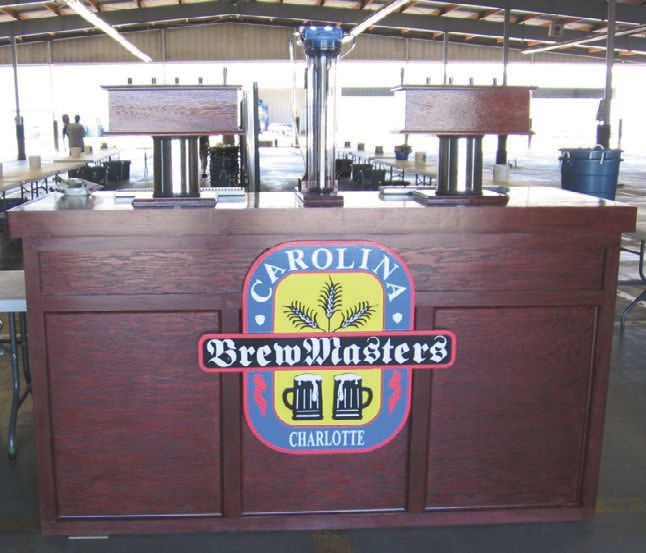
Carolina BrewMasters Oktoberfest Bar
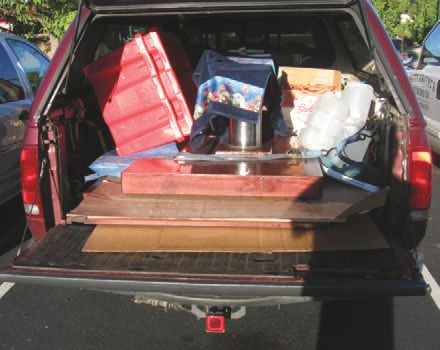
Pouring 11 beers and more than 30 kegs in a few short hours is par for the course for the Carolina BrewMasters during their Charlotte Oktoberfest. Tony Profera and his crew built a massive break-flat wooden bar featuring eight Ventmatic faucets, two Stout faucets and the Hopinator, a large custom-built Randall the Enamel Animal. Building their design around two removable old professional Irish Coffin Box towers, the bar is a statement in solidity and ease of use. Chilling each side are large red tubs holding six kegs apiece powered by separate CO2 manifolds with backflow protection. Gas cylinders rest in a wheeled oak box for service. The system breaks down completely, fitting into the rear bed of a pickup truck.

BrewPastor’s Altar (Tom Hart)
Tom Hart, a Presbyterian minister in New Mexico and former president of the Dukes of Ale brew club, made a huge splash at the National Homebrewers Conference in Denver with his BrewPastor’s Altar. Hart jokes, “Every beer drinker has a church key, and I decided I wanted an altar!”
A freezer-based bar with an Irish Coffin top sporting five taps and two hand pumps, the Altar is perfect for self-service situations with available power. Oak board and plywood braced with pine struts form a frame around an old slate blackboard, which serves as the mounting surface for the taps. To ease opening the new heavy top, Hart mounted the taps behind the hinge of the new freezer collar he built. Increasing the “bar-like” appearance of the freezer is an overhanging front oak surface. The CO2 manifold and temperature controller mount on a fold-down access panel behind the taps. Painting the freezer black completes the illusion of the altar and inspires devout worship. Are you contemplating a home bar? For a few dollars and more tool time, Hart’s design is within the reach of anyone building a basic freezer collar.


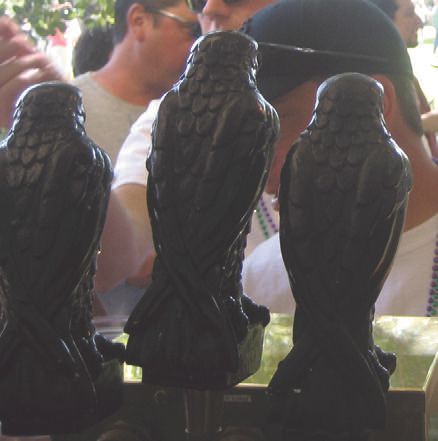
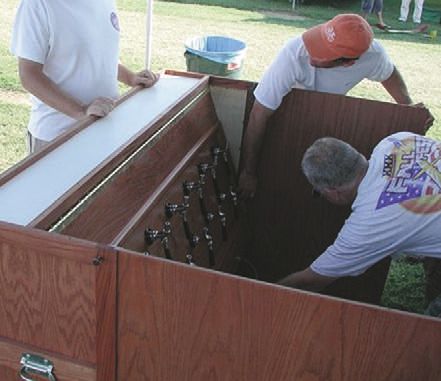
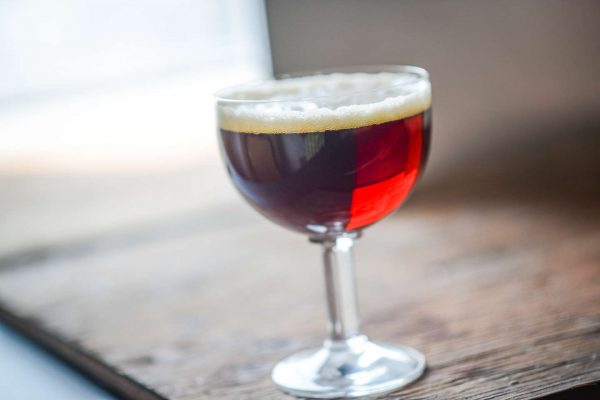
Share Post